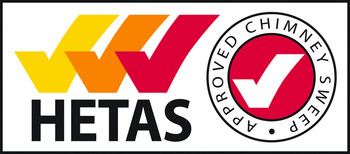Questions about the right fuel for stoves and more queries answered
- Do I need to line my chimney?
Choices for Relining Existing Chimneys:
Rebuilding or relining an existing chimney requires specialist advice. Providing the existing chimney structure is sound, there is a wide choice of factory made chimney relining systems that can be used. Fire-resistant precast concrete, clay and pumice flue liners or ceramic liners offer the most permanent solution, providing the existing chimney openings are big enough to take the correct flue size to suit the proposed appliance. Cast In-Situ lining systems are also available (see Section J of Part 2 of the HETAS Guide) which have been tested by an independent body, such as HETAS or BBA, to meet the appropriate requirements of BS EN 1857:2003 at the T400 N2 D 3 G level using tested materials which are installed under an accepted Code of Practice. It is desirable for such installations to be independently monitored under a QA inspection system.
Double skin flexible stainless steel flue liners offer an alternative answer if access is difficult or the existing chimney is unable to accept other types of liners. However, these flexible liners, whilst being easier to install and replace, are not permanent and significant periods of slow burning with solid fuels or infrequent chimney sweeping can cause corrosion damage which reduces the expected life to less than 5 years. Under no circumstances should a single skin flexible liner designed solely for use with gas fires be used with a solid fuel burning appliance. The efficiency and life expectancy of any chimney is dependent on correct use and maintenance. Masonry and precast chimney products whilst usually offering long life and high resistance to risk of corrosion, tend to involve more installation work, when compared with metallic chimney systems.
Metal liners and insulated metal chimneys offer fast and convenient installation. However, they are less resistant to damage by corrosion particularly if subjected to abuse or inadequate cleaning. Allowing soot or condensate deposits to accumulate in metal lined chimneys and also prolonged periods of burning solid fuel slowly in slumbering conditions, particularly on closed appliances, can cause high concentrations of corrosive condensates to build up and attack the metal liner. This situation can considerably reduce the life of the flue lining.
- How can I check if my appliance is HETAS Approved?
The Official Guide to HETAS Approved Products and Services lists all HETAS Approved Appliances, fuels, chimney products and ancillary equipment. The updated list can be found under the consumer tab of this site and clicking ‘HETAS Guide’. Alternatively, all HETAS Approved Products are also searchable here on the HETAS website. Click on the ‘Find Product’ search tab on the homepage, where you can search by size, manufacturer, fuel type or output.
- Is the fuel I am burning suitable for my appliance?
A full list of suitable fuels for your HETAS approved appliance will be given in your set of consumer operating instructions delivered with the appliance. For a directory on where to purchase HETAS approved fuels, click on ‘Find Fuels’ here or from the home page and search for your nearest supplier by entering your postcode.
- How often should I have my chimney swept?
A chimney or flue liner should be swept at least once a year when burning authorised smokeless fuels and at least twice a year when burning wood or bituminous coal.
- How can I find more information on correct use of my appliance?
HETAS now supply consumer advice sheets that are available to download free of charge from the HETAS website. For the full range of advice sheets available please follow the ‘Advice’ link here or under the consumer tab from the homepage.
- Should a CO alarm have been fitted when my appliance was installed?
Yes, from 2010 it is a legal requirement that a CO alarm must be fitted in the same room that the appliance has been installed in. Detailed guidance is provided in Building Regulations Approved Document J which can be found in the Regulations section of the website.
- Do I obtain any documentation once my installation is complete?
Yes, upon completion we will issue you with a HETAS certificate of compliance which shows that your appliance has been installed to the correct standard of practice and in accordance with Building Regulations. More information on the HETAS certificate of compliance can be found by clicking here.
We will get back to you as soon as possible
Oops, there was an error sending your query.
Please try again later



